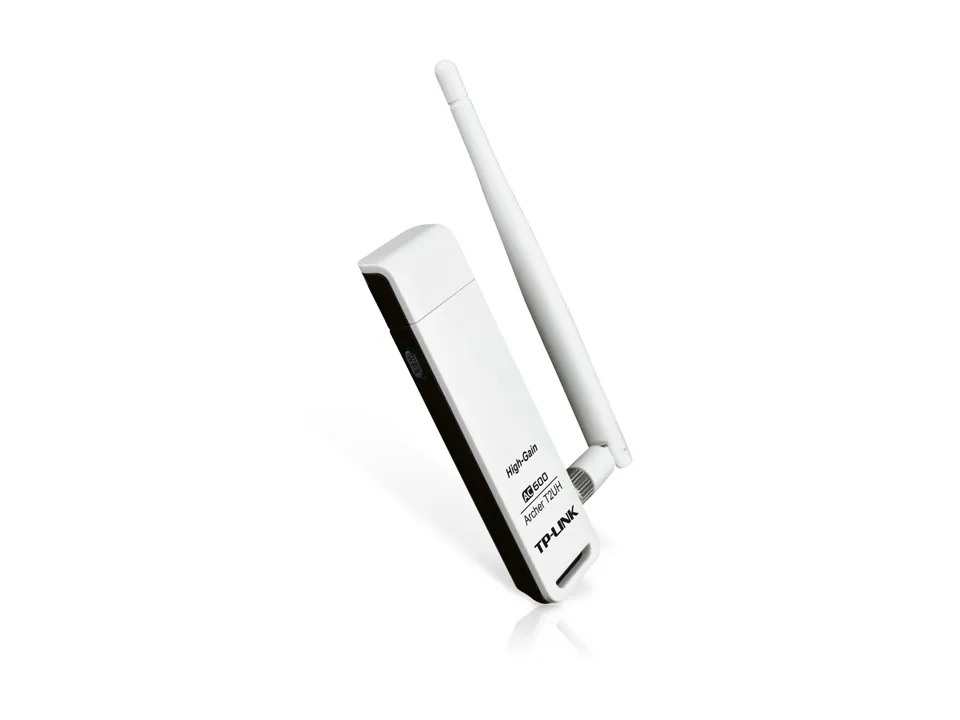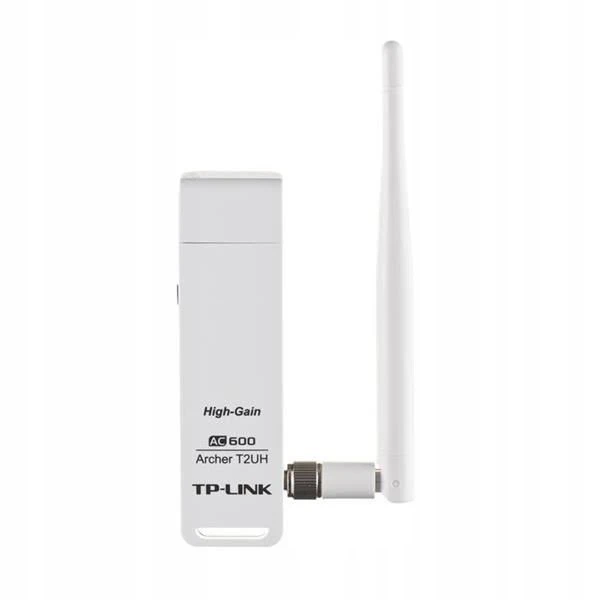TP-Link Archer T2UH | WiFi USB Adapter | AC600, Dual Band, 3dBi


TP-LINK Archer T2UH supports modern standard of 802.11ac Wi-Fi network. Archer T2UH offers enough bandwidth for smooth streaming of HD video, online games and other bandwidth-intensive activities. In addition, its sleek design can become an adornment of your home and office desk.

Archer T2UH allows all devices to connect at speeds up to 433 Mbps in the less loaded 5 GHz band or 150 Mbps in the 2.4 GHz band, which is typically used by most Wi-Fi networks today. The latest 802.11ac Wi-Fi standard is several times faster than previous standards, but only modern devices support it. The external Wi-Fi adapter TP-LINK Archer T2UH can be the solution, connected via USB, it can extend the connectivity even with older computers.

The ARCHER T2UH adapter is equipped with an external antenna with 3 dBi gain, which provides much better performance than internal antennas. Moreover, the antenna can be tilted or replaced with a stronger alternative if necessary.

| Equipment features | |
| Ports | USB 2.0 |
| Dimensions (S x G x W) | 93.5 x 26 x 11mm (3.7 x 1.0 x 0.4 inches) |
| Antenna type | Detachable, omnidirectional (RP-SMA) |
| Antenna gain | 3dBi |
| Wireless transmission characteristics | |
| Wireless standards | IEEE 802.11ac, IEEE 802.11a, IEEE 802.11n, IEEE 802.11g, IEEE 802.11b |
| Frequency of operation | 5GHz 2.4GHz |
| Transmission speed | 5GHz 11ac: up to 433Mb/s(dynamically) 11a: up to 54Mbps(dynamic) 2.4GHz 11n: up to 150Mbps(dynamic) 11g: up to 54Mb/s(dynamic) 11b: up to 11Mb/s(dynamic) |
| Receiver sensitivity | 5GHz: 11a 6Mbps: -94dBm 11a 54Mbps: -78dBm 11n HT20 MCS0: -94dBm 11n HT20 MCS7: -77dBm 11n HT40 MCS0: -92dBm 11n HT40 MCS7: -74dBm 11ac VHT80 MCS0: -89dBm 11ac VHT80 MCS9: -64dBm 2.4GHz: 11b 1Mbps: -99dBm 11b 11Mbps: -91dBm 11g 6Mbps: -94dBm 11g 54Mbps: -77dBm 11n HT20 MCS0: -95dBm 11n HT20 MCS7: -76dBm 11n HT40 MCS0: -92dBm 11n HT40 MCS7: -73dBm |
| EIRP | <20dBm (EIRP) |
| Wireless modes of operation | Ad-hoc / Infrastructure |
| Wireless transmission security | WEP 64/128 bit, WPA-PSK/WPA2-PSK, 802.1x |
| Modulation | DBPSK, DQPSK, CCK, OFDM, 16-QAM, 64-QAM, 256-QAM |
| Other | |
| Certificates | CE, FCC, RoHS |
| Package contents | Archer T2UH Wireless Network Card CD Quick Installation Guide USB extender |
| System requirements | Windows 10 (32/64bit), Windows 8.1 (32/64bit), Windows 8 (32/64bit), Windows 7 (32/64bit), Windows XP (32/64bit), Windows 10 (32/64bit), Mac OS X 10.7-10.13, Linux (kernel version 2.6~3.16) |
| Working environment | Operating temperature: 0℃~40℃ (32℉~104℉) Storage temperature: -40℃~70℃ (-40℉~158℉) Operating humidity: 10%~90%, non-condensing Storage humidity: 5%~90%, non-condensing |
Before the installation process begins, download the latest driver for the device from TP-Link's official website. To go to the right page, click here .
Then follow the instructions below:
1. Connect the network card to the computer.
2. Right-click the My Computer icon, select Manage.
3. Select Device Manager. Right-click the card name and select Update Device Driver.
4. Select Browse my computer for software.
5. Select Allow me to select from the list of device drivers installed on my computer.
6. Select Show all devices and press Next.
7. Press the Install from disk button.
8. press the Browse button.
9. Select a file from the driver folder and press the Open button.
10. Press the Next button.
11. Select Install software drivers nevertheless.
12. Press the Close button.
1) If you are using a different model (not Archer T1U) and your computer/device cannot detect any available wireless networks nearby, you will need to check the settings on your computer/device to ensure that the wireless adapter is installed correctly and turned on successfully. See frequently asked questions for details: Windows , Mac .
2) Check if the wireless switch is on.
3) Check your computer service settings. Go to Start and right-click Computer. Select and click Manage. A computer management window will appear. Under Services and applications, click Services. Scroll down and select Auto-configure WLAN. Make sure that it starts up and set the Start Type to " Automatic ".
4) Go to Control Panel -> Network and Sharing Center, try disabling this adapter and then turning it on again.
5) If necessary, contact your computer/wireless card/device operator for assistance.
1) Check the WLAN LED indicator on the router/wireless modem and make sure it is on or blinking. Check Wi-Fi on/off button and make sure Wi-Fi is on.
2) Check if you have disabled the SSID broadcast on your router. If Hide SSID is selected, you can no longer find your network.
3) Make sure that the computer / device is still within range of the router / modem. Try to get closer if you are currently too far away.
4) Check the wireless router settings: the name of the wireless network, whether the region/country is selected correctly and whether the wireless network is set to broadcast. If you do not know how to check your router's settings, please contact your router's technical support.